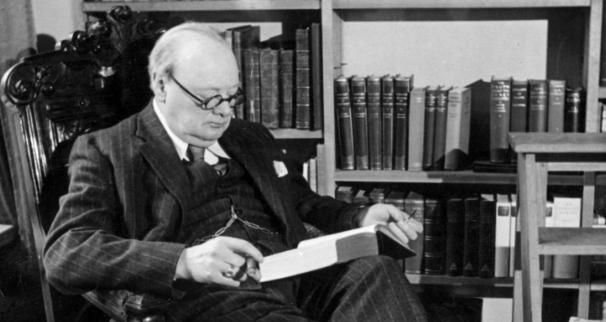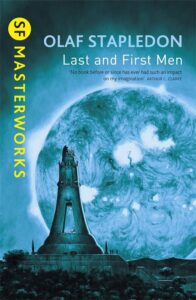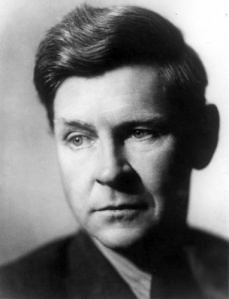
How Olaf Stapledon Inspired Churchill’s Vision
Excerpted from “Visions of the Future: Churchill and Olaf Stapledon,” written for the Hillsdale College Churchill Project. For the original article with endnotes, click here. To subscribe to weekly articles from Hillsdale-Churchill, click here and scroll to bottom. Enter your email in the box “Stay in touch with us.” We never spam you and your identity remains a riddle wrapped in a mystery inside an enigma.
“Fifty Years Hence”: Churchill’s Prediction
A colleague asks about a passage where Churchill credits another author, Olaf Stapledon, without naming him. It occurs in Churchill’s eerie and ominous 1931 essay, “Fifty Years Hence.” We owe our knowledge to the late Professor of English Paul Alkon, and his wonderful book Winston Churchill’s Imagination (2006).
“Fifty Years Hence” appeared in The Strand magazine in December 1931 and the American Review of Reviews in January 1932. Churchill gave it permanent life by including it in his book Thoughts and Adventures (1932). Churchill wrote as follows:

I read a book the other day which traced the history of mankind from the birth of the Solar System to its extinction. There were fifteen or sixteen races of men which in succession rose and fell over periods measured by tens of millions of years.
The book was Last and First Men by Olaf Stapledon. Churchill summarized:
In the end a race of beings was evolved which had mastered nature. A state was created whose citizens lived as long as they chose, enjoyed pleasures and sympathies incomparably wider than our own, navigated the interplanetary spaces, could recall the panorama of the past and foresee the future.
Over nine decades later, except for living as long as we choose, that passage sounds remarkably pertinent. And the questions it suggests are still there.
Olaf Stapledon
Despite his Christian name, Olaf Stapledon was born in Cheshire. Like Orwell, whose visions also impressed Churchill, he was a man of the Left. A conscientious objector, Stapledon drove ambulances in the Great War. While supporting the Second World War effort, he spoke on behalf of Richard Acland’s left-wing Common Wealth Party and the Federal Union. After the war, Stapledon fought against Apartheid in South Africa.
Paul Alkon was a leading teacher of Churchill’s philosophy. His book is one of the ten or twelve “Works About” one should pack along on a desert island. Indeed, without it, we would not know of the Stapledon influence. Paul wrote:
In satire and science fiction, Churchill is far from Aldous Huxley’s equal. Nevertheless it is remarkable that as a writer, Churchill was alert to the same intellectual and artistic currents that prompted Brave New World, and able to produce related forms of writing. In “Fifty Years Hence” Churchill unmistakably alludes, although not by name, to another science fiction classic: Olaf Stapledon’s 1930 novel, Last and First Men.
I found no Stapledon-Churchill correspondence in the Churchill Archives. Nevertheless, Paul Alkon’s reference is important. Of course, other futurists influenced Churchill’s famous essay, such as H.G. Wells, and Karel Čapek. But Churchill’s reference is specifically to Stapledon’s book. He certainly would have respected him as much as he did Wells, though politically they were poles apart.
The ominous message of “Fifty Years Hence”
After citing Stapledon in “Fifty Years Hence,” Churchill draws worrisome implications about the future of mankind:
Without an equal growth of Mercy, Pity, Peace and Love, Science herself may destroy all that makes human life majestic and tolerable. There never was a time when the inherent virtue of human beings required more strong and confident expression in daily life; there never was a time when the hope of immortality and the disdain of earthly power and achievement were more necessary for the safety of the children of men.
There never was a time? How pertinent Churchill remains to present-day affairs. Returning to Stapledon and his “race of superior beings,” Churchill asks:
What was the good…? What did they know more than we know about the answers to the simple questions which man has asked since the earliest dawn of reason— “Why are we here? What is the purpose of life? Whither are we going?”
A hundred years hence

We are close to a century since Churchill and Stapledon wrote those words. Today’s dangers are not the same as those of their time. It is foolish, concluded Paul Alkon, to believe our times are simply a replay of theirs.
Churchill’s lasting value lies in his approach—not precisely what he did, but the broad principles he applied. These were concepts he defended: liberty, the individual, law, courage, magnanimity—the precepts of his country and its relatives across the seas, combined as a force for good.
The vision of Stapledon as interpreted by Churchill is brought up to date by Dr. Larry Arnn in his book, Churchill’s Trial. And that is a good place to leave this thread, in the hands of a thinker who extrapolates Churchill’s vision as the age of Artificial Intelligence unfolds:
Churchill thought that when the conquest of nature becomes the signal object, the result will be the conquest of man…. Churchill wrote in “Fifty Years Hence” that we may soon be able to make people to order, to breed them in laboratories. If we can do that, we can make them better and worse, depending upon the jobs we want them to do. Once we begin this—and it is possible now—we will be making people to suit our convenience. Some will be not just ruling, but creating others as tools.*
*Larry P. Arnn, Churchill’s Trial: Winston Churchill and the Salvation of Free Government (Nashville: Thomas Nelson, 2015), 167.
More on Churchill’s imagination
Paul Alkon, “‘Shall We All Commit Suicide?’: Churchill’s Scientific Imagination,” 2020. Part 1 and Part 2.
_____ _____, “Churchill’s Alternative History: Lee’s Triumph at Gettysburg,” 2020.
Fred Glueckstein, “Churchill and H.G. Wells, the Two Futurists,” Hillsdale College Churchill Project, 2018.
Richard M. Langworth, “Churchill, Wells, and Government by Experts,” 2022.
______ ______, “Churchill’s Visions of the Future in Thoughts and Adventures,” 2018.






